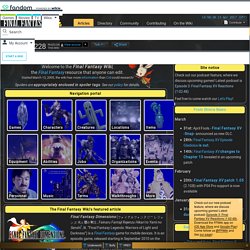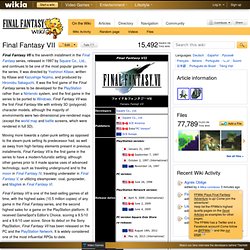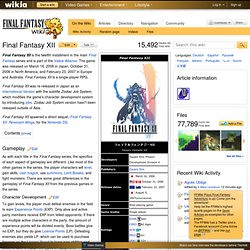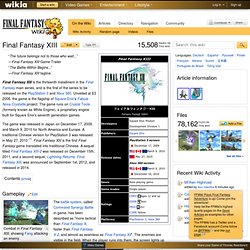

Final Fantasy Wiki - Welcome to the Final Fantasy Wiki! In November 2014, Square Enix announced a new Final Fantasy Dimensions game titled Final Fantasy Legends: Toki no Suishō where soundtracks from the original game were incorporated.

No localization has been announced. In November 2016, following the conclusion of the game's first storyline, Square Enix rebranded Final Fanasy Legends: Toki no Suishō to Final Fantasy Legends II. (more...) Final Fantasy VII. November 8, 2006 Moving more towards a cyber-punk setting as opposed to the steam-punk setting its predecessor had, as well as away from high-fantasy elements present in previous installments, Final Fantasy VII is the first game in the series to have a modern/futuristic setting; although other games prior to it made sparse uses of advanced technology, such as traveling underground and to the moon in Final Fantasy IV, traveling underwater in Final Fantasy V, or utilizing steampower, coal, gunpowder, and Magitek in Final Fantasy VI.

Final Fantasy VII is one of the best-selling games of all time, with the highest sales (10.5 million copies) of any game in the Final Fantasy series, and the second highest sales for a game on the PlayStation platform. It received GameSpot's Editor's Choice, scoring a 9.5/10 and a 9.6/10 user score. Final Fantasy VIII. April 1, 2011 Thirteen weeks after its release, Final Fantasy VIII earned more than $50 million from sales in the United States, making it the fastest selling Final Fantasy title at the time.

Additionally, Final Fantasy VIII was voted the 22nd-best game of all time by readers of the Japanese magazine Famitsu. Final Fantasy VIII went on to become one of the best-selling games in the series; the game had shipped 8.15 million copies worldwide as of March 31, 2003. Gameplay. Final Fantasy X. April 15, 2012 Due to Final Fantasy X's success and popularity, it spawned the first-ever direct game sequel to a Final Fantasy game: Final Fantasy X-2, released in 2003-04, which continued the events of Spira two years later through the eyes of Yuna.

This came about as the result of an initial concept of spinning off Yuna and Rikku into individual titles of their own, which was later combined into one game. A remastered HD version of Final Fantasy X was announced at the Sony Press Conference in Japan on September 14, 2011 as part of a 10th anniversary special, and was released on the PlayStation 3 and PlayStation Vita.[2] Gameplay Edit.
Final Fantasy XII. Final Fantasy XII was re-released in Japan as an International Version with the subtitle Zodiac Job System, which modifies the game's character development system by introducing jobs.

Zodiac Job System version hasn't been released outside of Asia. Final Fantasy XII spawned a direct sequel, Final Fantasy XII: Revenant Wings, for the Nintendo DS. Gameplay Edit Character Development Edit To gain levels, the player must defeat enemies in the field to earn Experience Points (EXP). In the Zodiac Job System version what abilities a character can learn and what equipment they can use is dictated by their job. Magick Main article: Magick Effect Capacity dictates how many magick spells and other special abilities can be executed simultaneously; all of the most powerful magicks use all of the effect capacity meaning when the player casts the game's most powerful magicks other actions are queued until the spell animation has finished.
Summons/Espers Quickenings/Concurrences Battle See also: Gambits Edit Traps. Final Fantasy XIII. April 1, 2010 “The future belongs not to those who wait...”

—Final Fantasy XIII Game Trailer “The Battle Within Begins...” —Final Fantasy XIII tagline The game was released in Japan on December 17, 2009, and March 9, 2010 for North America and Europe. Gameplay Edit The Active Time Battle bar returns, but this time it is divided into sections. A new element called the Chain Gauge is specific to each enemy, and fills as the player performs attack combos marked by a percentage. When a battle is won, a Battle Results screen pops up, giving the player a zero-to-five stars ranking on how they did, as well as showing how long the battle took. Save Stations allow the player not only to save, but access the shops in Retail Network where items can be bought or sold. Equipment Edit Each character has eight unique base weapons, most of which can be found during the course of the game, and all of which can be purchased at Retail Network stores.
All characters can equip all accessories. Paradigm Shift Setting. The Elder Scrolls Wiki. The BioShock Wiki - BioShock, BioShock 2, BioShock Infinite, and more. Lost Odyssey Wiki - Walkthroughs, guides, skills, and more.